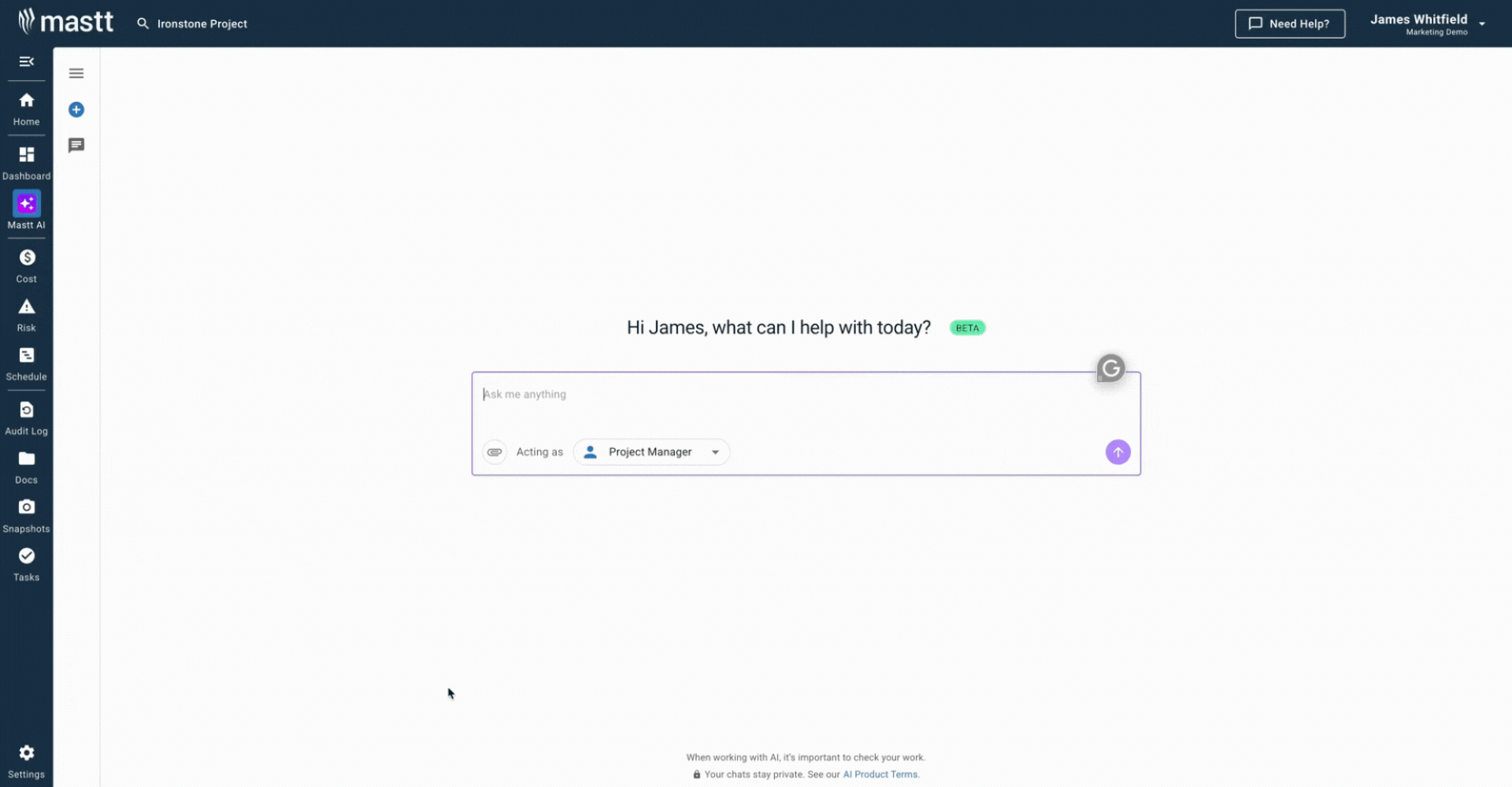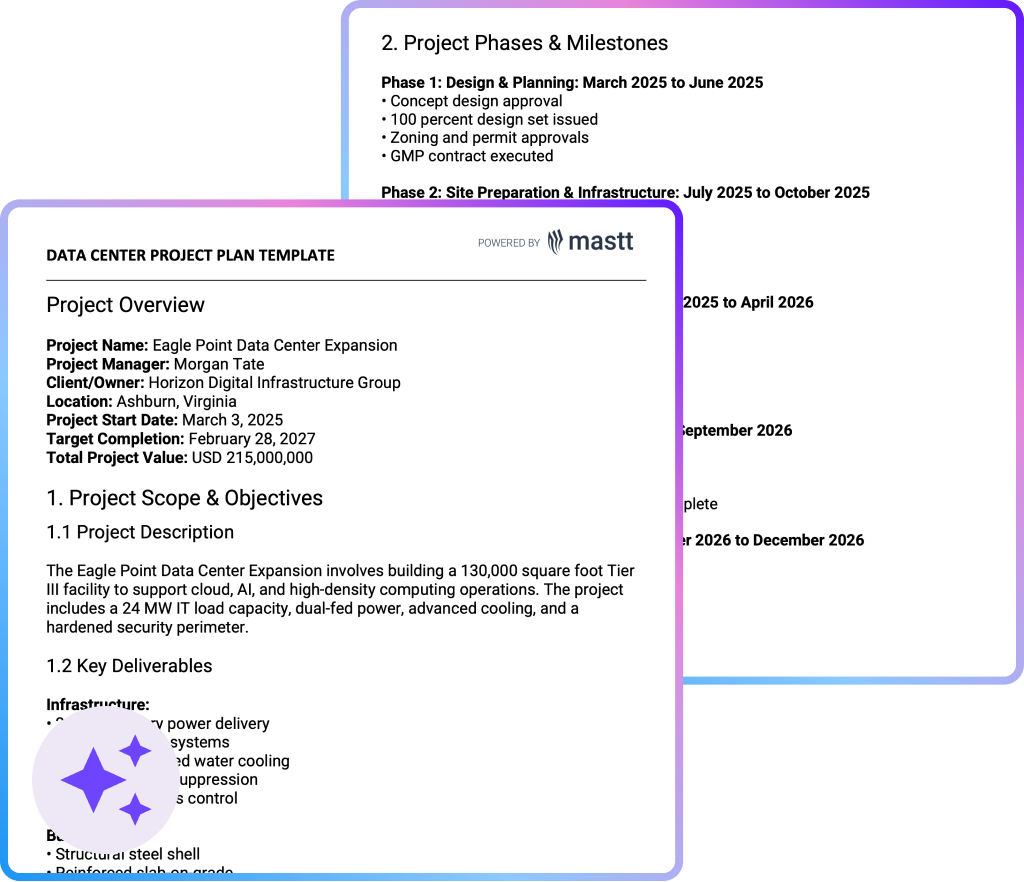What is a Data Center Project Plan Template?
A data center project plan template is a pre-structured framework that organizes the development, migration, or construction of data center facilities. It provides ready-made sections for planning phases, tracking milestones, coordinating disciplines, and managing deliverables across IT, electrical, mechanical, and network infrastructure.
The template typically includes project phases from site selection through commissioning, resource allocation charts, timeline structures, and deliverable checklists. Most formats use Gantt charts, Excel spreadsheets, or project management software structures with built-in formulas and progress tracking fields.
Data center teams use these templates to coordinate complex buildouts involving power systems, cooling infrastructure, server deployment, and network installation. The structured format ensures nothing gets missed during the 12-36 month delivery timeline that characterizes most data center projects.
What's Included in Data Center Project Plans?
A data center project plan contains project phases organized chronologically from concept through operational handover. The structure captures infrastructure deployment, IT installation, testing, and commissioning activities across the project life cycle.
Here are the essential components most data center setup project plans include:
- Site Selection and Feasibility: Location analysis for power availability, fiber connectivity, cooling capacity, and network proximity.
- Design and Engineering: Architectural layouts, MEP specifications, redundancy configurations, and capacity planning with growth buffers.
- Permitting and Approvals: Building permits, utility agreements, environmental assessments, and regulatory compliance.
- Infrastructure Procurement: Equipment ordering for generators, UPS systems, cooling units, and power distribution with long lead times.
- Construction Activities: Foundation work, raised floors, electrical systems, HVAC installation, and fire suppression coordination.
- Power and Cooling Systems: Utility connections, backup generators, UPS deployment, and redundancy testing for uptime validation.
- Network Infrastructure: Fiber installation, structured cabling, server racks, and connectivity testing before deployment.
- Testing and Commissioning: Load testing, systems integration, failover validation, and performance benchmarking before acceptance.
- Operational Handover: As-built documentation, team training, warranty registration, and maintenance procedures.
💡 Pro Tip: Include detailed procurement lead times for every piece of equipment in your plan. Most teams track when equipment arrives but miss ordering deadlines. A generator ordered late delays electrical work, HVAC installation, and commissioning by months.
Why Data Center Teams Need Project Plan Templates
Data center teams should have project plan templates because coordinating multiple disciplines across long timelines creates overwhelming complexity. A project planning template prevents costly delays and coordination failures that plague complex infrastructure projects.
Structured templates deliver critical advantages:
- Prevent schedule delays: Pre-defined phases keep equipment procurement aligned with construction milestones.
- Coordinate specialized teams: Templates organize IT, electrical, mechanical, and network groups around shared timelines.
- Manage procurement complexity: Tracking equipment lead times prevents delivery delays that halt construction progress.
- Control project budgets: Structured cost tracking identifies overruns early across multi-million dollar investments.
- Ensure regulatory compliance: Built-in checkpoints for permits and approvals prevent work stoppages.
- Minimize migration downtime: Phased cutover planning reduces disruption when downtime costs thousands per minute.
- Track critical dependencies: Templates show which activities must complete before others start.
- Maintain stakeholder alignment: Consistent reporting keeps executives informed throughout multi-year delivery cycles.
Teams using structured data center build project plans spot resource conflicts months earlier. Early visibility prevents emergency expediting fees and schedule crashes.
How to Develop a Data Center Project Plan
Developing an effective data center project plan requires organizing phases from planning through handover while tracking dependencies between workstreams. Effective planning balances technical requirements, budget constraints, and timeline realities.
Follow these steps to build comprehensive data center plans:
- Define project scope: Establish whether planning construction, migration, or consolidation, then document capacity needs and uptime targets.
- Identify project phases: Break into logical stages including planning, design, permitting, procurement, construction, testing, and commissioning.
- Map critical milestones: Establish decision points like design freeze, permit approval, equipment delivery, and go-live dates.
- Build procurement schedule: List equipment with ordering deadlines working backward from installation dates ensuring delivery.
- Establish task dependencies: Document which activities must complete before others start, particularly infrastructure readiness requirements.
- Assign ownership: Designate responsible parties for each phase including project managers, facilities teams, and contractors.
- Create risk plans: Identify potential delays, establish contingency timelines, and define escalation procedures.
- Set communication protocols: Define reporting frequency, stakeholder meetings, and escalation pathways ensuring alignment.
- Document change control: Create procedures for evaluating scope changes and assessing impacts before implementation.
💡 Pro Tip: Schedule weekly cross-discipline meetings during design and construction. Data center projects fail when electrical teams don't know mechanical plans. Weekly coordination catches conflicts before they become expensive field changes.
Generate Project-Specific Data Center Plans with Mastt AI
Mastt AI eliminates the manual formatting work that delays data center project planning. Instead of adapting generic downloads or building templates from scratch, you generate customized structures matching your facility requirements.
Here's what Mastt AI delivers for data center planning:
🚀 Create plans instantly: Generate complete structures with phases, milestones, and deliverables for construction, migration, or consolidation projects.
📂 Upload existing documentation: Import preliminary designs, equipment specs, or vendor proposals. Mastt AI incorporates this into planning frameworks.
🎯 Refine through conversation: Describe adjustments like adding commissioning phases or expanding testing activities. Mastt AI updates the structure accordingly.
⚡ Download ready-to-use formats: Export complete plans as Word or Excel files ready for stakeholder review.
Getting started with data center project planning:
- Describe your project: Tell Mastt AI whether planning construction, migration, or consolidation, including capacity and timeline needs.
- Upload supporting documents: Add preliminary designs, equipment specs, or existing documentation to inform the structure.
- Review generated framework: Examine the complete plan including phases, milestones, and deliverables tailored to your specs.
- Refine through conversation: Request modifications like expanding procurement tracking until the plan matches requirements exactly.
- Download and deploy: Export the finalized data center build out project plan as Word or Excel ready for distribution.
Every conversation stays private in your secure workspace. Your data center project details and planning documents remain confidential.
👉 Learn more in the Mastt Help Center

Who Should Use Data Center Setup Project Plans?
Construction project planning matters most for professionals coordinating complex infrastructure deployments across multiple technical disciplines. But structured planning frameworks benefit anyone managing the timeline, budget, or technical requirements for data center facilities.
Data center project plans are essential for:
✅ Data Center Project Managers: Coordinate end-to-end facility buildouts from site selection through commissioning, managing budgets, timelines, and specialized contractor teams across 12-36 month delivery cycles.
✅ IT Directors and CIOs: Plan data center migrations or consolidations minimizing business disruption, coordinate application cutover schedules, and manage capacity planning aligning infrastructure with growth projections.
✅ Facilities Managers: Oversee data center construction activities coordinating MEP contractors, ensure infrastructure redundancy meets uptime requirements, and manage commissioning testing before operational handover.
✅ Construction Project Managers: Deliver data center construction coordinating specialized trades, track critical path activities preventing schedule delays, and ensure quality control standards throughout buildout phases.
✅ Data Center Developers: Plan greenfield facility developments managing site selection, utility interconnection, permitting timelines, and multi-phase buildout schedules across portfolio investments.
✅ IT Infrastructure Engineers: Plan server deployments coordinating network infrastructure installation, manage equipment procurement with long lead times, and oversee system integration during cutover phases.
✅ MEP Engineers: Design and oversee installation of power, cooling, and mechanical systems ensuring redundancy requirements, coordinating load testing, and validating performance against specifications.
✅ Operations Managers: Plan data center migrations with minimal downtime coordinating cutover activities, manage risk mitigation during transitions, and ensure business continuity throughout consolidation projects.
✅ Program Managers: Oversee portfolios of data center projects coordinating resources across facilities, standardize delivery processes, and report progress to executives and investment committees.
When to Use Data Center Buildout Project Plans
Teams deploy a data center project plan template when coordinating complex infrastructure across extended timelines. The structured framework becomes essential during specific project stages and decision points.
Data center planning templates are critical during these phases:
- Initial Feasibility Planning: Before committing capital, organize site selection, capacity planning, and ROI projections into frameworks supporting decisions.
- Design Phase Kickoff: When translating requirements into specifications, structure architectural design, MEP engineering, and capacity forecasting.
- Procurement Planning: Before construction starts, organize equipment ordering with long lead times for generators, UPS systems, and cooling.
- Construction Management: During buildout, coordinate foundation work, electrical installation, mechanical systems, and network infrastructure across specialized trades.
- Migration and Consolidation: When transitioning operations, structure phased cutover plans, application schedules, and rollback procedures minimizing disruption.
- Testing and Commissioning: Before acceptance, organize systems testing, load validation, failover testing, and performance benchmarking.
- Multi-Phase Development: When building in stages, coordinate initial completion with expansion planning and future capacity deployment.
💡 Pro Tip: Start planning 18-24 months before needing capacity online. Data center projects take longer than expected. Early planning prevents schedule crashes and cost premiums from compressed timelines.
Common Problems with Generic PDF and Excel Data Center Project Plans
Data center project plan PDF files and Excel spreadsheets break down as projects scale across phases and disciplines. Static documents create coordination gaps that lead to missed dependencies and budget overruns.
⚠️ Outdated plans within weeks: Excel templates require manual updates, so plans fall behind actual construction progress and schedule changes.
⚠️ No real-time collaboration: PDF plans can't be updated simultaneously by MEP engineers, IT teams, and construction managers.
⚠️ Broken formulas destroy accuracy: Complex Excel calculations break when rows get added or columns shift during updates.
⚠️ Disconnected from actual progress: Spreadsheets don't link to payment applications, equipment deliveries, or commissioning results.
⚠️ Multiple conflicting versions: Different stakeholders maintain separate Excel files, creating confusion about current project status.
⚠️ Can't track dependencies: Excel struggles showing how electrical delays impact network schedules or procurement affects construction timelines.
⚠️ Limited stakeholder visibility: PDF reports require manual generation, leaving executives without real-time visibility into project status.
⚠️ Change tracking fails: Excel can't document why timelines shifted or how modifications impact budget forecasts.
If your data center project plan hasn't been updated in more than two weeks, it's providing false confidence. Stale plans cause more problems than no plan because teams make decisions based on incorrect information.
Streamline Data Center Development with Mastt
Managing data center projects with static PDF files and Excel spreadsheets leaves teams reacting to coordination failures. Manual plans fall behind reality, creating gaps between planned and actual project status.
For data center teams needing reliable coordination, Mastt AI generates a customized data center project plan template matching your facility requirements. No more adapting generic downloads or conflicting spreadsheet versions.
👉 Generate your data center project plan template with Mastt AI today and stop scrambling to coordinate specialized disciplines.









